As a business owner, you need to be able to reach the right people with your marketing. If you aren’t reaching people that have an interest in or a specific need for your services, you’ll waste valuable time and resources and miss your revenue goals.
Creating target audiences that align with your ideal client profile on digital platforms that they frequent enables you to focus your inbound lead generation campaigns on those most likely to engage with your brand, convert into customers, and become loyal advocates.
When you know exactly who you are reaching, you can tailor your messaging and offerings to match your specific audience’s needs, preferences, and pain points and, by doing so, get a higher response.
In this blog post, we’ll discuss how to build your target audiences for inbound lead-generation campaigns. We’ll cover various methods and tools to help you develop target audiences that align with your ideal client profile so that you can create more targeted and effective digital marketing campaigns.
Here’s what we’ll cover:
- What is a Target Audience?
- Typical Problems Creating Target Audiences
- Target Audience Success Stories
- How to Develop Your Target Audience
- How to Build a Target Audience for Search Marketing
- How to Build a Target Audience for Use on the Google Display Network
- How to Build a Target Audience for Facebook Ads
- How to Build a Target Audience for LinkedIn Ads
- Example of Building a Target Audience
- Frequently Asked Questions
What is a Target Audience?
Let’s define a target audience before diving into the specifics of building your target audience.
Your target audience is a specific list of people most likely to be interested in your products or services. These people will most likely purchase from you, engage with your content, and spread the word about your brand.
Developing target audiences that align with your ideal client profile is crucial for effective marketing. It allows you to create content and campaigns that speak directly to their needs, pain points, and interests.
Typical Problems with Creating Target Audiences
As a business, you’re eager to promote your products or services to the world. So, you launch your marketing campaigns with anticipation, but something feels off. The response is lackluster, and your message seems to fall on deaf ears. What could be the culprit behind this disheartening outcome?
Creating target audiences for effective marketing involves navigating common challenges. One challenge arises when the target audience is too broad or large. In this scenario, tailoring marketing efforts becomes daunting as the messaging becomes generic and fails to resonate with individuals. Consequently, valuable resources may be wasted on uninterested prospects.
Conversely, an overly specific or narrow target audience can pose problems by limiting marketing campaigns’ reach and growth potential. Generating enough leads and conversions becomes difficult, hindering the sustainability of the business.
Think of it like this:
- Too Broad/Large: When the target audience is overly broad, it’s challenging to tailor marketing efforts effectively. The messaging becomes generic, and resources may be wasted on uninterested individuals.
- Too Specific/Small: Overly narrow target audiences limit reach and growth potential. Generating enough leads and conversions becomes difficult, hindering sustainability.
- Lack of Evaluation: Failure to regularly evaluate target audiences can lead to missed optimization opportunities. Analyzing data and monitoring campaign performance is crucial for maintaining an effective and aligned marketing strategy.
By strategically striking the right balance and continuously evaluating and refining your approach, you can create lead-generation campaigns that truly resonate with your ideal customers, leading to greater engagement, conversions, and, ultimately, the growth and success of your business.
Target Audience Success Stories
Here are some practical examples of how adjusting your target audience to better align with your ideal client profile can make a big difference:
Document Management Service: This company offers a service for digitizing physical records using a scanning device. They had been running paid search ads but weren’t seeing many good leads despite several thousand dollars in monthly ad spend. An audit of the search queries triggering their ads revealed that over 90% of their ad spend had been going to search queries that were similar their target, but not aligned with their service (“lottery ticket scanner” and “cat scan”). Adjustments to their target audience settings greatly improved their results, contributing to a 331% increase in web leads.
Commercial Surface Installer: This company installs poured rubber surfaces for playgrounds in commercial settings: schools, daycares, churches, minimal parks, etc. They were getting 200+ leads from their website, but nearly 70% of those leads were not a good fit due to the inquiries from homeowners seeking a similar solution for their home playgrounds. Home installs were typically not a good fit due to size, budget, and other factors. After adjusting audience targeting, website copy, and lead forms, they improved their lead quality by 230%.
How to Develop Your Target Audiences
1. Review Your Ideal Client Profile
Reviewing your ideal client profile is the first step in building your target audience. An ideal client profile is a detailed description of the type of contacts that best fit your business. An ideal client profile typically includes specific criteria for your best clients’ demographic attributes, behavior patterns, motivations, and goals.
If you don’t already have a defined ideal client profile, you can develop one by gathering data about your existing customers and their market. This data can come from various sources, including customer surveys, website analytics, social media insights, and market research reports. If you’d like to learn more about developing a data-based ideal client profile, check out this in-depth blog article that describes how to develop one. The article also includes links to a free worksheet and training video that guides you through the process.
Once you have your ideal client profile in hand, review it to familiarize yourself with observable traits, such as:
- Industry: The target industry or industries in your profile will help you target the right contacts industry of the company they work for. If you target a single industry or similar industries, you may also be able to tailor your messaging to those industries.
- Company Size: Many platforms can target audiences based on the annual revenue or number of employees.
- Location: Most platforms enable you to target based on the company or contact location.
- Age: Knowing the age demographics of your target audience helps you tailor your marketing messages and content to resonate with their preferences and life stages.
- Gender: Understanding the gender composition of your target audience allows you to personalize your communication, branding, and product offerings to cater to their specific needs and interests.
- Education level: Identifying the educational backgrounds of your target audience enables you to adapt your messaging and content complexity to suit their level of knowledge and expertise.
- Job title: Recognizing the job titles or roles that resonate with your target audience allows you to craft relevant and engaging marketing materials that address their specific professional challenges and goals.
- Interests: Exploring the interests and hobbies of your target audience helps you identify potential points of connection and engagement, allowing you to tailor your content and campaigns accordingly.
- Pain points: Understanding the pain points and challenges your target audience faces enables you to offer solutions and position your products or services as valuable problem-solving tools.
- Goals: Determining the goals and aspirations of your target audience allows you to align your messaging and positioning to showcase how your offerings can help them achieve their desired outcomes.
- Purchase Criteria: Analyzing the buying behavior of your target audience provides insights into their purchasing preferences, allowing you to optimize your marketing strategies, channels, and tactics to meet their needs and preferences effectively.
Having reviewed your ideal client profile, you will be primed to build your target audiences.
2. Analyze Your Current Audiences
If you already have a website, social media following, or a prospect list, you may already have an audience you could be marketing. Before you start working to build new audiences, it makes sense to assess these existing audiences. Just as warm referrals convert to sales faster than cold leads, an existing audience may perform better than a cold audience. However, if you haven’t done a lot of targeted marketing, these audiences may be rather small or not well aligned with your ideal client profile, so it’s important to analyze them before deciding if or how to use existing audiences for marketing.
Google Analytics
Google Analytics is a powerful tool to help you analyze your current audience. It provides data on your website visitors, including their demographics, interests, and behaviors.
To use Google Analytics to identify your audience, go to the Audience section and explore the various reports available. Here are a few reports to pay attention to:
- Demographics: This report provides data on your visitors’ age and gender.
- Interests: This report shows the interests and affinity categories of your visitors.
- Behavior: This report provides information on your visitors’ behavior, such as new vs. returning visitors and pages per session.
- Geo: This report shows the location of your visitors.
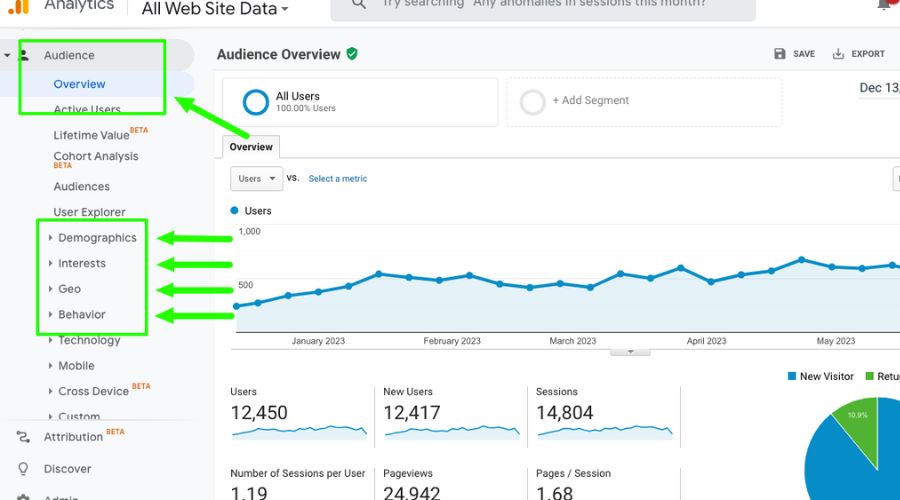
By analyzing this data, you can better understand your current website audience and their behavior on your website. If you find that your website visitors align well with your ideal client profile, you can “re-target” them by serving ads to them when they visit websites that offer ad placements through display networks such as Google Ads. You can even create specific lists of users based on their website behavior. For instance, you could create an audience that consists of all users that visited a certain group of pages or spent a specified amount of time on the website.
Social Media Audiences
Social platforms like LinkedIn, Facebook, and Instagram offer data on your followers.
LinkedIn Audience Profile
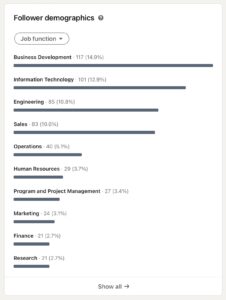


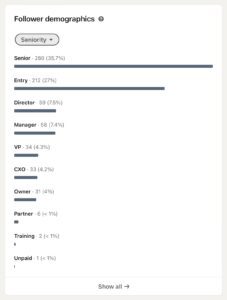
Facebook Audience Insights (includes Instagram followers)
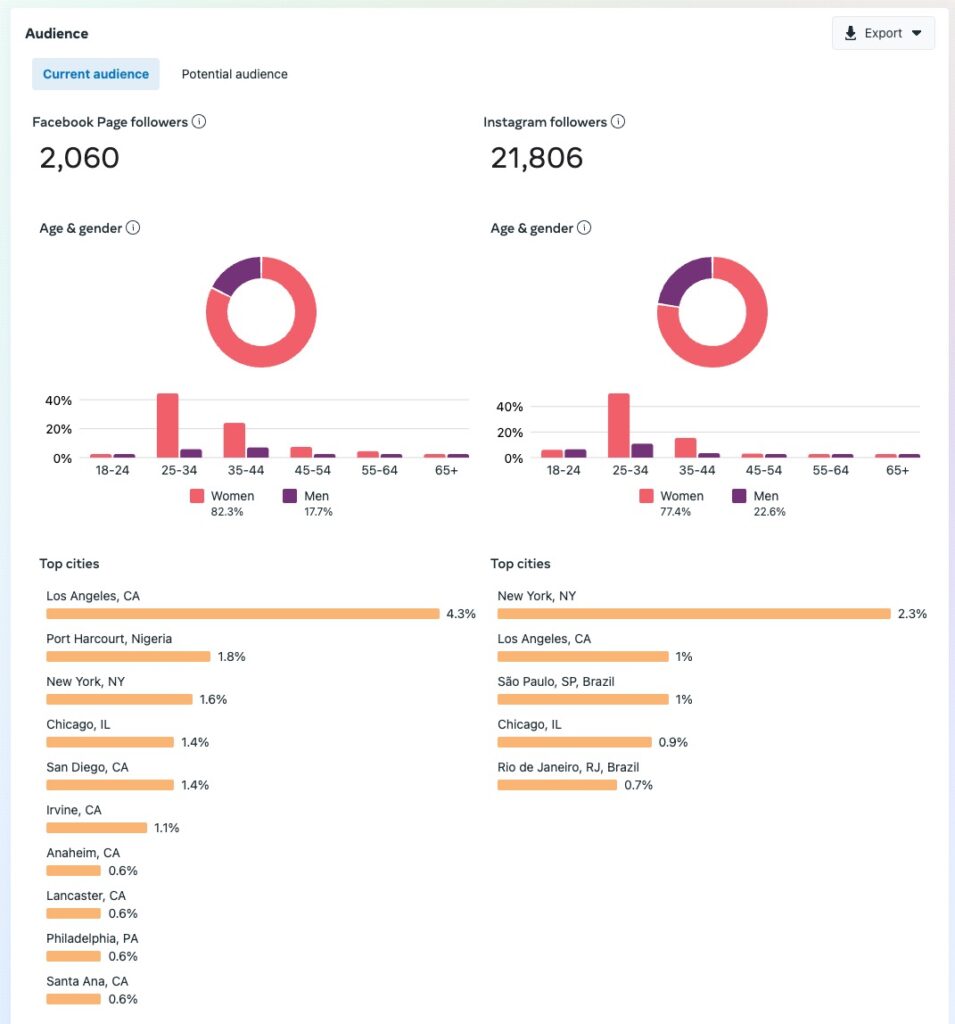
If your current social media followers are aligned with your ideal client profile and the follower counts are large enough, you could reach your existing audiences through organic posts or sponsored ad placements offered by that platform. You can also build “lookalike audiences” that would enable you to target new people with similar traits to your existing audience. This is often more effective than developing new audiences, provided your existing audience aligns with your ideal client profile.
Prospect Lists (from Email Marketing or Customer Relationship Management Software)
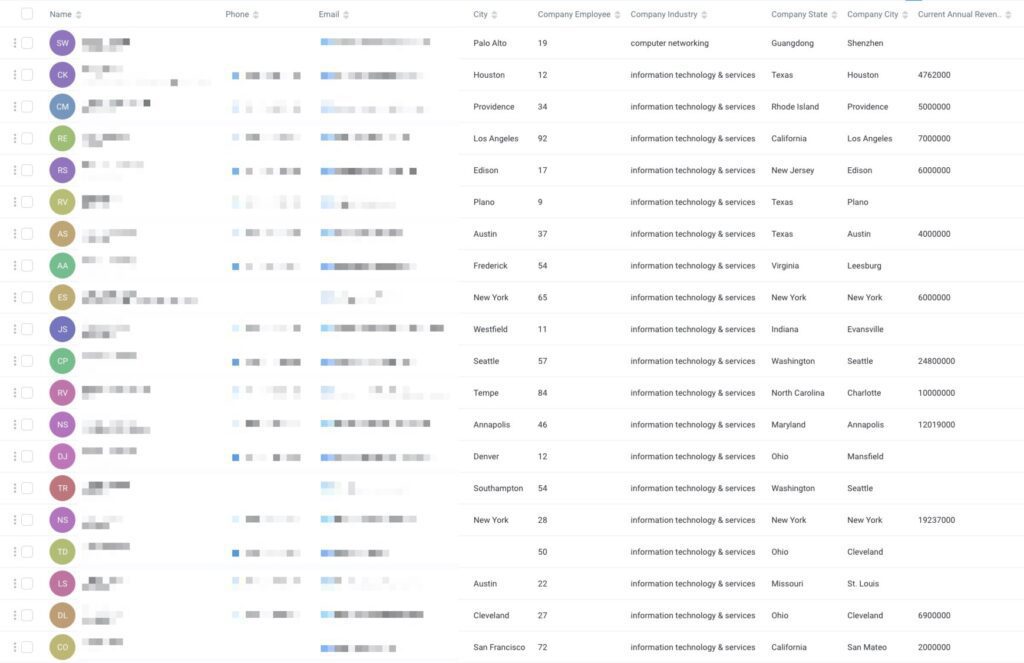
If you maintain a list of prospects or leads in your customer relationship management system (CRM), this can provide some good insights and possible email or text message (SMS) marketing opportunities if you have their email address or mobile numbers. If your CRM contains any demographic data, you assess how well those lists align with your ideal client profile. Provided they are aligned, you could send promotional emails to this audience and would likely see a decent response rate since they already know your brand. You could also upload these lists to ad platforms and develop “lookalike audiences” by matching users on their platforms.
Studying your current website, social, and email audiences will help you assess how well your existing audiences align with your ideal client profile and whether they are sufficient to meet your marketing goals or if you need to develop new or larger audiences.
3. Develop Your Target Audience
You can develop target audiences on many different channels. The most common include:
Search Engines
Target users searching keywords that align with how your ideal clients might search for services you offer. This is typically done by working to earn organic rankings for target keywords on popular search engines like Google or Bing via search engine optimization techniques. Another tactic is to pay to rank for target keywords using Google Ads or Microsoft Ads platforms.
Social Media
Target users with traits that align with your ideal client profile and frequent popular social media platforms like Facebook, Instagram, or LinkedIn. This can be done via organic social media marketing, influencer marketing, or via sponsored ad placements using platforms like Facebook Ads or LinkedIn Campaign Manager.
Display Ads
Target users with traits that align with your ideal client profile via display ads, also known as banner ads. This can be done in several ways, but the most common is via the Google Display Network, which has an inventory of more than 2 million websites and a sophisticated set of targeting criteria.
Other Digital Channels
While the above are the most common platforms, there are many other options to reach your ideal clients, including:
- Video Ads
- Over-the-Top TV Ads
- Email Outreach
- SMS Messaging Campaigns
- Industry Directory Placements
- Sponsored Content Placements (ex: OutBrain)
- Audio Ads on Podcasts and Online Radio Channels
- Banner Ads on News or Media Sites
How to Develop Your Target Audience Using Facebook Ads
Facebook Audience Insights is a free tool that provides data on Facebook users, including their demographics, interests, and behavior. You can also use it to create custom audiences and estimate their size for use with targeted ad campaigns on Facebook or Instagram using the Facebook Ads platform.
To use Facebook Audience Insights, go to Facebook Ads Manager and select Audience Insights. Then, enter the interests and behaviors of your target audience and any demographic information you have. Facebook will then provide data on your potential audience’s size, interests, behaviors, and demographics.

You can use this data to create targeted Facebook ads that are more likely to resonate with your target audience.
Problems to Avoid When Using Facebook Ads
- Avoid targeting too broadly or narrowly, as this can result in wasted ad spend or missed opportunities.
- Avoid relying too heavily on broad demographic targeting, as this can result in reaching people who are not likely to be interested in your products or services.
- Neglecting to regularly review and adjust your target audience and creative to optimize your campaigns.
How to Develop a Target Audience Using Google Ads Keyword Planner
Google Keyword Planner is a free tool that helps you estimate the search volume for specific keywords. It can help you understand the size of your target audience searching for keywords related to your products or services.
To use Google Keyword Planner, enter a keyword related to your business and select the location and language of your target audience. Google will then provide data on the average monthly searches for that keyword and related keywords and their search volumes.
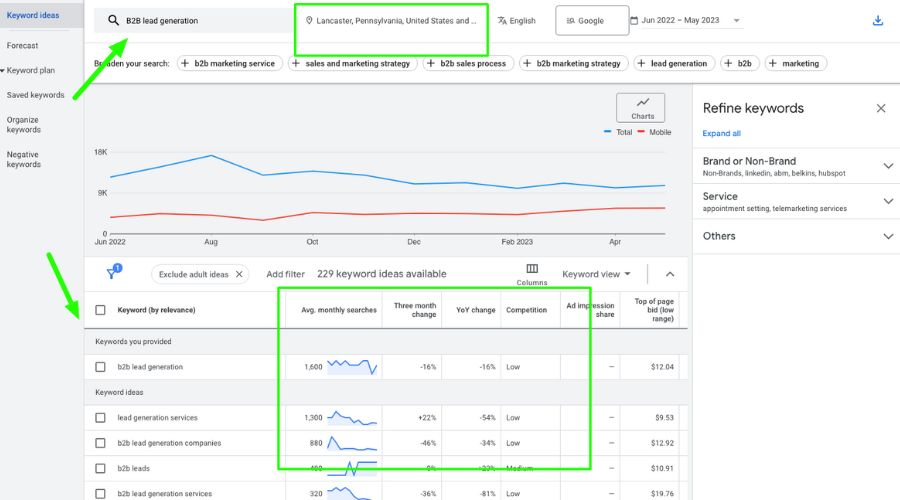
This data can help you estimate the size of your target audience searching for keywords related to your business. It can also help you identify new keywords to target in your SEO and PPC campaigns.
Problems to Avoid for Google Search Ads
- Don’t rely too heavily on broad match keywords: While broad match keywords can help you reach a larger audience, they can also lead to irrelevant clicks and wasted ad spend. Instead, focus on exact match or phrase match keywords to ensure that your ads are shown to users searching for specific terms related to your product or service.
- Avoid targeting too many locations: If you’re targeting multiple locations with your Google Search Ads campaigns, ensuring each location is relevant to your business is important. Targeting too many locations can dilute your messaging and make it difficult to reach users most likely to convert.
- Don’t neglect negative keywords: Negative keywords allow you to exclude specific search terms from your campaigns to ensure that your ads are only shown to relevant users. Failing to use negative keywords can result in wasted ad spend and irrelevant clicks.
- Avoid overly broad demographic targeting: While demographic targeting can effectively reach specific user groups, it’s important to avoid targeting too broad an audience. Instead, focus on targeting users most likely to be interested in your product or service based on age, gender, or other relevant factors.
- Don’t forget to optimize your landing pages: While targeting the right audience is important, ensuring that your landing pages are optimized for conversion is also crucial. Be sure to test different landing page variations and make adjustments based on user behavior to maximize your results.
How to Develop Audiences for the Google Display Network
The Google Display Network allows you to reach people across millions of websites and apps by showing ads matching their interests and behavior. To build target audiences on the Google Display Network, you can use the following targeting options:
- Demographic targeting: Target people based on age, gender, parental status, household income, and education.
- Contextual targeting: Target people based on the website content they are browsing.
- Interest targeting: Target people based on their interests and habits, such as travel, sports, or technology.
- Remarketing: Target people who have visited your website and shown interest in your products or services.
- Similar audiences: Target people who share similar characteristics with your existing customers.
Using these targeting options, you can build more targeted and effective audiences for your Google Display Network campaigns.
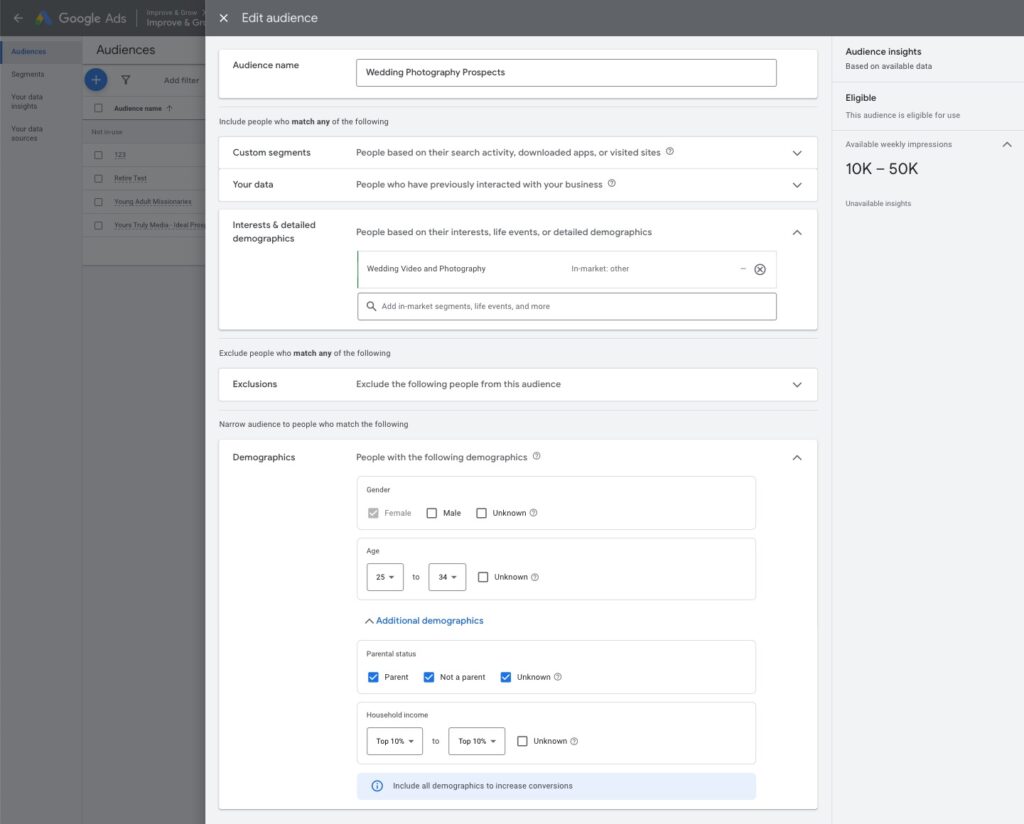
Problems to Avoid on the Google Display Network
- Avoid relying solely on interest targeting, as it can be less effective than other targeting options like contextual or remarketing targeting.
- Avoid targeting too broadly, as this can result in wasted ad spend on users who are not likely to be interested in your products or services.
- Avoid targeting only one specific audience, as this can limit your reach and potentially miss out on potential customers.
How to Develop a Target Audience Using LinkedIn Ads
LinkedIn Ads is a powerful platform for B2B marketing that allows you to reach decision-makers and professionals in your industry. To estimate the size of your target audience on LinkedIn Ads, you can use the following steps:
- Identify your target audience based on their job title, industry, company size, and location.
- Use LinkedIn’s audience forecasting tool to estimate the size of your target audience and the potential reach of your campaigns.
- Refine your targeting based on the estimated audience size and adjust your bid accordingly.
For example, if you are targeting marketing managers in the United States, LinkedIn’s audience forecasting tool can estimate the size of your target audience and the potential reach of your campaigns. Based on this information, You can adjust your targeting and bid to optimize your LinkedIn Ads campaigns.

Problems to Avoid on LinkedIn Ads
- Avoid targeting too narrow, as this can limit your reach and potentially miss out on potential customers.
- Avoid targeting only based on job title, as this can result in reaching individuals who may not be decision-makers in their organizations.
- Avoid neglecting to test different targeting options and creative to optimize your campaigns.
Practical Example of Building Target Audiences
Understanding the importance of accurately identifying and estimating your target audience is essential for successful digital advertising. In this example, we’ll explore a proven strategy that focuses on leveraging digital advertising platforms to build your target audience. By implementing these steps, you can enhance your digital advertising efforts, reach the right audience, and maximize your campaign’s effectiveness. Let’s dive into the details:
Example:
Imagine a technology consulting organization specializing in cloud computing services to businesses using the Snowflake Cloud platform. This company aims to build its target audience on various digital advertising platforms to build awareness, drive traffic to its website, and generate leads for its services.
Step 1: Review Ideal Client Profile
The organization begins by defining its audience segments based on relevant criteria such as industry, company size, job title, and geographic location. They identify the following attributes of their ideal clients:
- Mid-sized US-based companies in data-rich sectors incl. Tech, Financial Services, and Healthcare
- Decision-makers typically have C-level titles such as CIO, CTO, or CMO
- Primary contacts are usually in the 35-55 age range and have interests in cloud computing, big data management, and business intelligence software
Step 2: Analyze Current Audience
This company is a start-up, so they don’t have much in the way of a target audience. However, they partner closely with an organization that offers similar solutions and were able to verify many of their assumptions about their ideal clients including the industries, job titles, and age range. They also narrowed their target company size down to companies with 1,000-10,000 employees.
Step 3: Develop Target Audience
With increased clarity on their ideal client attributes, the organization set upon developing target audiences. They explored their potential reach via search engines, display ad networks, and social media platforms.
Google Ads Keyword Planner
They used Google Keyword Planner to estimate their audience size based on relevant keywords. Their research found over 90,000 monthly searches for relevant keywords, 10,000 of which had high purchase intent and made sense to target with search ads.
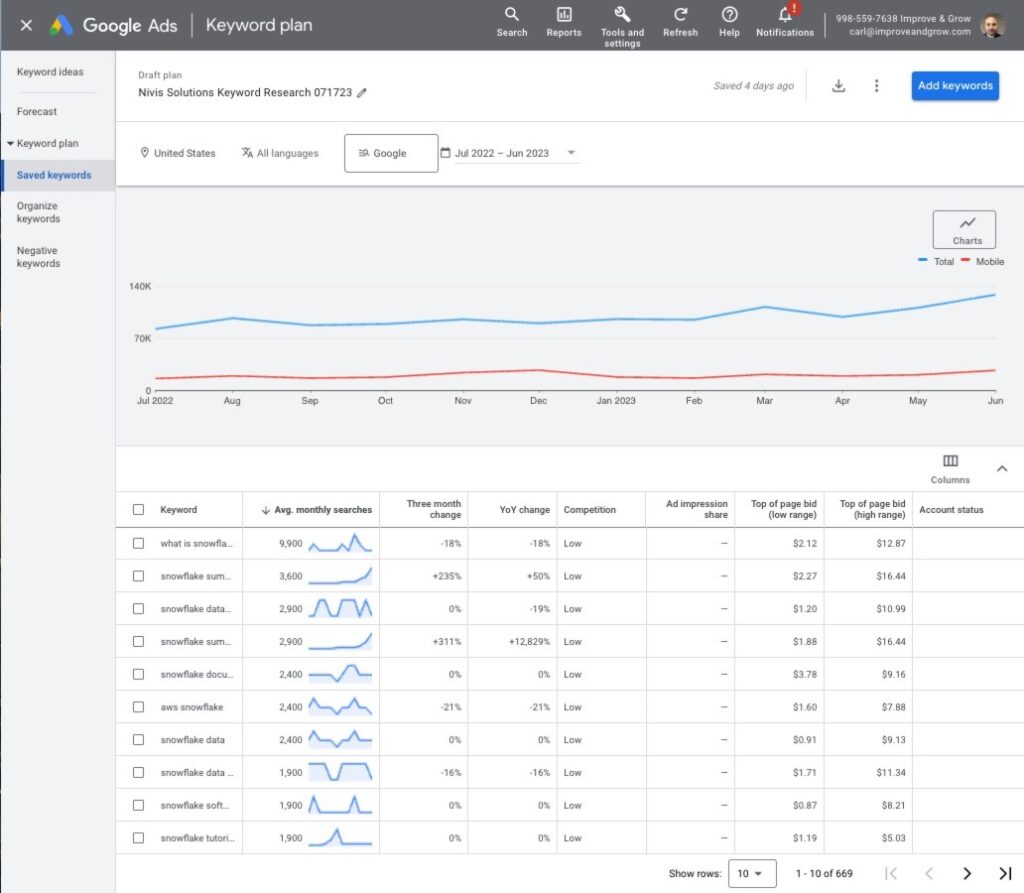
Google Ads Audience Manager
They used the Google Ads Audience Manager to develop a custom segment that targets users interested in or who have recently searched for Snowflake solutions in the US. They found they could reach 100,000+ users every week that met these criteria via the Google Display Network.
LinkedIn Ads Audience
They used the LinkedIn Campaign Manager Audience tool to develop a saved audience targeting LinkedIn users who worked at mid-size companies in selected industries interested in cloud data management. They found that they could reach over 96,000 users that meet this criteria.

With this information in hand, the organization can effectively build and reach its target audience by following these steps and leveraging digital advertising platforms like Google Ads, Google Display Network,and LinkedIn Advertising. This targeted approach will ensure that their ads are seen by people that align with their ideal client profile, increasing the likelihood of attracting qualified leads and driving conversions. They also plan to closely monitor the performance of their digital advertising campaigns using metrics such as click-through rates, conversions, and audience engagement to understand what resonates with their target audience. Based on these insights, they will make data-driven optimizations, refining their targeting, ad creative, and messaging to maximize their campaign’s effectiveness.
Conclusion
Building your target audience size is essential for effective digital marketing. By understanding your target audience’s demographics, behavior, interests, and pain points, you can create more targeted and effective marketing campaigns that resonate with your ideal customers. Using tools such as Google Keyword Planner, Facebook Audience Insights, and LinkedIn Campaign Manager, you can estimate the size of your target audience and gain clarity on how many ideal fit prospects you could reach on those platforms.
Developing your target audience is an important step in developing an effective digital marketing strategy. With clarity on the size and nature of. Your target audience, you can begin developing targeted marketing campaigns that will attract, engage, and convert ideal prospects into warm sales leads!
Do you already have a clear digital marketing strategy that will meet your organization’s revenue goals? If not, we invite you to discover the proven 9-step process we use to help our clients develop a data-backed digital marketing strategy. Start Here >>
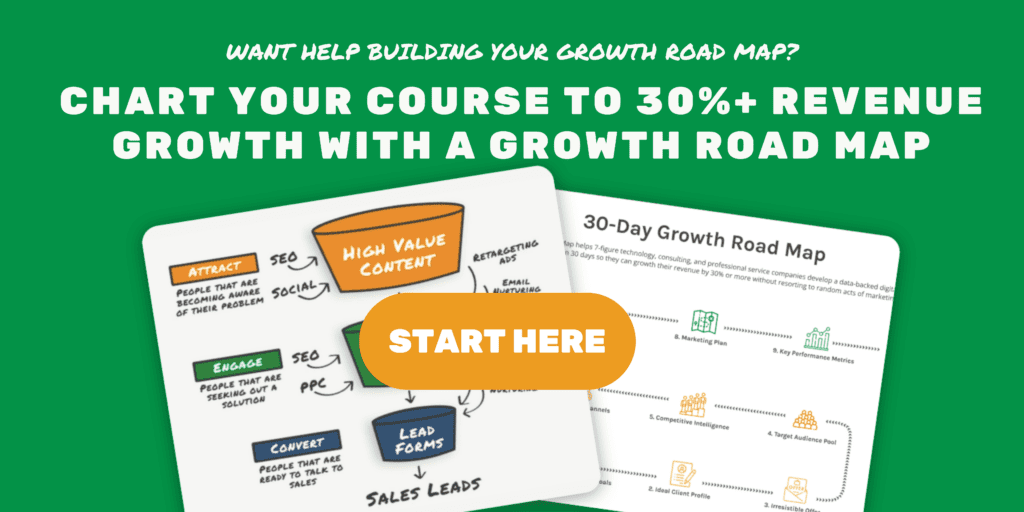
Frequently Asked Questions
How large should your target audience be on each of these platforms?
There isn’t a one-size-fits-all answer to how large your target audience should be on each platform, as it can vary depending on your business goals, budget, and targeting criteria. However, here are some general guidelines to keep in mind:
Facebook Ads: Facebook recommends having a target audience of at least 100,000 people for your campaigns to be effective. However, you may want to narrow your targeting further to ensure that you’re reaching the most relevant users.
Google Ads: There isn’t a specific size recommendation for target audiences on Google Ads, as the platform offers a wide range of targeting options. However, it’s generally a good idea to narrow your targeting to ensure that you’re reaching the most relevant users.
Google Display Network: The Google Display Network offers a variety of targeting options, including contextual targeting and audience targeting. If you’re using audience targeting, it’s recommended to have a target audience of at least 1,000 people.
LinkedIn Ads: LinkedIn recommends having a target audience of at least 50,000 people for your campaigns to be effective. However, you may want to narrow your targeting further to ensure that you’re reaching the most relevant users.
Keep in mind that the size of your target audience isn’t the only factor that impacts the effectiveness of your campaigns. It’s also important to consider the quality of your targeting criteria, ad copy and creative, and landing pages. Regularly review your data and make adjustments as needed to ensure that you’re reaching the right people with your marketing efforts.
What if your target audience is smaller than these guidelines?
If your target audience is smaller than the recommended guidelines for a particular platform, it may be more challenging to reach the minimum number of users required to run a successful campaign. However, there are still strategies you can use to maximize your results, such as:
Expand your targeting criteria: Consider broadening your targeting criteria to include additional demographics, interests, or behaviors. This can help you reach more users while still maintaining relevance.
Use lookalike audiences: Lookalike audiences allow you to target users who are similar to your existing customers or subscribers, even if your target audience is smaller than the recommended guidelines. This can help you expand your reach and find new potential customers.
Experiment with different ad formats: Depending on the platform, there may be different ad formats available that can help you reach a smaller target audience more effectively. For example, on LinkedIn, sponsored InMail messages can be effective for reaching smaller target audiences.
Consider retargeting: Retargeting allows you to target users who have previously visited your site or engaged with your content, even if your target audience is smaller than the recommended guidelines. This can be a powerful way to bring users back to your site and encourage them to take action. While it may be more challenging to reach a smaller target audience, it’s still possible to run effective campaigns with the right targeting criteria, ad copy, and creative and landing pages. Be sure to regularly review your data and make adjustments as needed to ensure that you’re maximizing your results.
What if the target audience is too big?
If your target audience is too big, it can be challenging to reach the most relevant users and to achieve your campaign goals. Here are some strategies to consider if your target audience is too large:
Narrow your targeting criteria: Consider refining your targeting criteria to reach a more specific audience. This can help you reach users who are most likely to be interested in your product or service and to take the desired action.
Use exclusion targeting: Exclusion targeting allows you to exclude certain demographics, interests, or behaviors from your target audience. This can help you reach a more specific audience while also ensuring that you’re not wasting ad spend on users who are unlikely to convert.
Use audience segmentation: If your target audience is too broad, consider breaking it down into smaller segments based on demographics, interests, or behaviors. This can help you create more targeted messaging and ad creative that resonates with each segment.
Experiment with different ad formats: Depending on the platform, there may be different ad formats available that can help you reach a larger target audience more effectively. For example, on Facebook, carousel ads or video ads can be effective for capturing users’ attention and driving engagement.
Adjust your bidding strategy: If your target audience is too large, you may be competing with many other advertisers for ad space. Consider adjusting your bidding strategy to focus on the most valuable users within your target audience, such as those who are most likely to convert or have the highest customer lifetime value.
Keep in mind that it’s important to regularly review your data and make adjustments as needed to ensure that you’re reaching the right users with your marketing efforts. By refining your targeting criteria and experimenting with different strategies, you can achieve better results even with a large target audience.
What to do if the target audience isn’t performing well?
If your target audience isn’t performing well, it’s important to take a data-driven approach to identify the root causes and make adjustments. Here are some steps you can take to improve the performance of your target audience:
Review your targeting criteria: Start by reviewing your targeting criteria to ensure that it aligns with your ideal client profile. Look for any areas where you may be targeting the wrong demographics, interests, or behaviors.
Review your ad copy and creative: Your ad copy and creative can have a big impact on how well your target audience performs. Look for opportunities to improve your messaging or creative to better align with your target audience’s interests and pain points.
Test different targeting criteria: If your current targeting isn’t performing well, consider testing different criteria to see if you can improve performance. This might include testing different demographics, interests, or behaviors.
Optimize your landing pages: Even if you’re targeting the right audience, your landing pages may be preventing users from converting. Look for opportunities to optimize your landing pages for conversion, such as improving load times, adding social proof, or simplifying the user experience.
Consider retargeting: If your target audience isn’t converting on the first visit, retargeting can be a powerful way to bring them back to your site and encourage them to take action. Consider setting up retargeting campaigns to target users who have previously visited your site or engaged with your content.
Keep in mind that improving the performance of your target audience is an ongoing process. Regularly review your data and make adjustments as needed to ensure that you’re reaching the right people with your marketing efforts.
Learn more
How can you create target audiences that align with your ideal client profile?
Creating target audiences that align with your ideal client profile is an important step in ensuring that you’re reaching the right people with your marketing efforts. Here are some tips for creating target audiences that align with your ideal client profile:
Define your ideal client: Start by creating a detailed profile of your ideal client, including demographic information, interests, behaviors, and pain points. This will serve as the foundation for your target audience.
Use lookalike audiences: Platforms like Facebook and LinkedIn offer lookalike audience targeting, which allows you to reach users who are similar to your existing customers or website visitors. This can be a powerful way to expand your reach while still targeting users who are likely to be interested in your products or services.
Leverage customer data: Use your existing customer data to inform your target audience. Look at demographic information, purchase history, and other data points to create targeting criteria that align with your ideal client profile.
Use keyword targeting: Platforms like Google Ads and the Google Display Network offer keyword targeting, which allows you to target users based on the keywords they’re searching for or the content they’re viewing online. This can be a powerful way to reach users who are actively interested in your products or services.
Test and optimize: Creating target audiences is an ongoing process, and it’s important to regularly test and optimize your targeting criteria to ensure that you’re reaching the right people. Use performance data to identify areas for improvement and adjust your targeting accordingly.
By following these tips, you can create target audiences that align with your ideal client profile and increase the effectiveness of your marketing efforts.
Learn more
How can you tell if your target audience is right?
Determining whether your target audience is the right one for your business can be challenging, but there are several key indicators to look for:
Engagement: If your target audience is engaged with your ads and content, it’s a good sign that you’re reaching the right people. Look for metrics like click-through rates, time spent on site, and social media engagement to gauge how well your target audience is responding.
Conversion rates: Ultimately, the success of your target audience comes down to whether they’re converting into customers or taking other desired actions. Look at conversion rates to determine whether your target audience is responding positively to your ads and content.
Customer feedback: Talk to your existing customers to get their feedback on your products or services, and ask them how they found out about your business. If your target audience aligns with your existing customer base, it’s likely that you’re reaching the right people.
Competitor analysis: Look at your competitors and their target audience to see if there are any similarities or differences. If your target audience is similar to those of successful competitors in your industry, it’s a good indication that you’re on the right track.
Audience research: Conduct audience research to learn more about the demographics, interests, and behaviors of your target audience. This can help you refine your targeting and ensure that you’re reaching the right people.
Keep in mind that determining whether your target audience is the right one is an ongoing process. Regularly review and adjust your targeting based on feedback and performance data to ensure that you’re reaching the right people with your ads and content.




